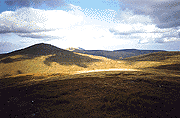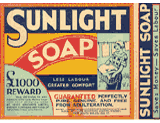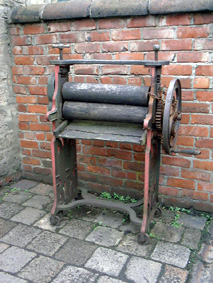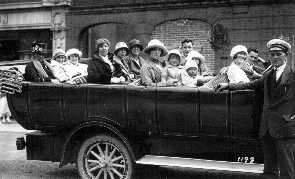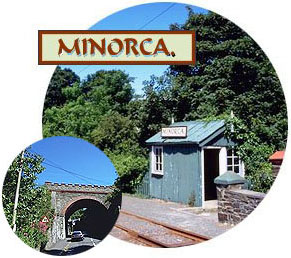THE SYCAMORES
When I was about twelve years old we left Glamorgan House and moved to The Sycamores. Situated just beyond the village, on the road to Ramsey, we were in a good position for local shopping but quite a little distance from the beach. Not that this made a great deal of difference to us. In the summer months we still spent quite a lot of time down by the sea.
My three cousins came over to the Island every summer from Liverpool and spent their holiday with us. So, with my brother Des and myself, we were quite a little party enjoying the pleasures of Laxey beach.
To get there from the Sycamores we would walk about a quarter of a mile to Minorca, then downhill to Old Laxey and so to the beach. Going home meant climbing the hill which was quite steep, but it never seemed to worry us, or at any rate I cannot remember it as a problem.
Much as I had loved Glamorgan House and particularly its proximity to the beach, for me our new house was an even better proposition. By this time I had also moved up into the senior school and that, added to the change of house, marked a sort of dichotomy between my earlier life and what must have seemed a more grown up existence.
The house itself was a pleasant building, light and airy with plenty of space. Downstairs, apart from the dining and sitting rooms, there was a smaller one known as the morning room - a really snug and cosy place to have breakfast in the winter. There were dark green velvet curtains and some of my grandmother's furniture. With a fire burning in the hearth under the dark oak timbered overmantel, there was a sense of warm security, almost of time standing still.
In summer the dining room was preferable. It had windows facing both south and east and got all the morning sun. There was honeysuckle growing just outside and with the windows open its scent came gently in. My mother had pale green, silky, unlined curtains here. If the sun dazzled us and we drew them they swayed in the breeze, casting mysterious, tantalising patterns about the walls.
The furniture was golden oak which did not at all match the fireplace, a tall mahogany chimney piece full of nooks and little cupboards with glass doors up the sides. But who cared for that? The table was very large, taking up an enormous amount of space since we kept all the leaves in it. This was because we used it regularly with great gusto, for playing table tennis.
In those days we had fenders in front of fireplaces because with coal fires there was always the danger of coals falling out. In the dining room it was brass. I distinctly remember my mother sometimes sitting by the fire having a late breakfast after the rest of us, and sharing her toast and marmalade with both the dog and the cat!
We had one of the early toasters, not one that 'popped up' the toast, but no doubt we thought ourselves very modern. In one respect we were somewhat ahead of the times. Mother had a coffee pot, a cafetiere type with a perforated inner lid which pushed the grounds to the bottom of the pot. They are quite common to-day but I doubt if there were very many of them in 1930.
My parents were both coffee drinkers and before the advent of the cafetiere Mother simply poured water over the coffee and used a strainer when pouring out. However, she and two of her women friends had a holiday together in Paris - and there she discovered the cafetiere. From then on, we were never without one.
The sitting room faced south and west. It was a peaceful room, decorated in pale French grey and white with touches of rose in the furniture. The grey walls were 'panelled' by very pretty white swags of raised plaster. The fireplace was of pink and white marble, with, under the mantelpiece, a white enamelled frieze. Here in bold relief, was Boudicca, proudly driving her chariot across. In those days of course, she was known to us as Boadicea.
There was a laburnum tree, I remember, outside the west window. I cannot see one to-day without being transported back in memory to that sitting room, and I see again the light and shade playing across the pale walls as the afternoon sun shone through the fronds of yellow blossom dancing in the wind.
Upstairs there were five bedrooms, four good-sized ones and a boxroom of much the same size as the average third bedroom to-day. From my window I had a clear view of Snaefell with its 'hotel' at the top. Another flight of stairs led to a storage area and a further two rooms. One of these became a den for my brother and the other was given over to the maid.
When we first moved to the Sycamores, Des was not more than about six years old. There came a time however, when he was in his teens, when in that same den he nearly drove my poor father distracted by playing the drums!
The house had a cellar under the sitting room. It was surprisingly light because although mainly underground, it had a window, higher up than normal of course, giving on to the front garden. We used to store the apples there throughout the winter so there was always a good supply. I can remember only one occasion when things went wrong.
For some reason which no one explained to me, the cellar became flooded. The apples were all floating in about a foot or so of water and had to be rescued. It was a great adventure. Chairs were carried down the cellar steps and placed at strategic points so that we did not need to wade through the extremely cold water. We then went chair hopping from one spot to another, picking up the apples and putting them carefully in baskets to be taken up to the kitchen for drying.
The kitchen had a quarry tiled floor and the usual range with two ovens heated by the fire. A common method of sweeping such a floor was to sprinkle it first with drained off, used tea leaves to keep down any dust. Facing north there were two small rooms leading off from the kitchen, one of them being a storage room.
I particularly remember a whole cupboardful of jams and preserves. There was any amount of fruit and raw material in the garden which Mother turned into jams and pickles and jellies and salted vegetables. When I make raspberry jam for my grandchildren to-day, the aroma brings my mother and that childhood kitchen instantly and nostalgically to mind.
The other small room was what to-day would be termed a utility room. Apart from shelves however, the only utility in it was the porcelain sink with a grooved wooden drainboard. We did not have washing machines in those days. There were no fridges or freezers or other appliances which seem to be so essential to us today. But as far as possible, larders, pantries or store rooms would usually face north and be kept cool behind closed doors.
For us the laundry was done mostly by someone from the village who would collect it in its own laundry bag. Two or three days later she would return it, in its own clean bag, all beautifully washed, ironed and if required, starched. And the ironing might well have been done with a flat-iron heated on a little iron stand which clipped on to the side and hung over the fire. I say 'might have been' because we ourselves did have one just like that.
Near the back door there was an outside lavatory and also a washhouse with a coalhouse to one side. Apart from small items any laundry done at home would take place in the washhouse. This was a separate building and contained a boiler which was a fixture. It would be filled with water and a fire lit in the grate below to heat it. Heavy articles such as sheets could then be boiled.
An essential item for the laundry was the 'bluebag' which was used to whiten the whites. This could be bought at either of the stores in the village, Williamson's or the Co-operative, and was normally sold in little solid, square or round packs.
At home it would then be tied into a piece of cotton or linen with plenty of material above the tie so that it was not necessary to handle it too much. It would be well mixed into the final rinsing water, taking care not to allow the washing to become streaky.
I cannot remember if we had soap powder at that time but one all important cleanser was a bar of hard kitchen soap: in our case it was 'Sunlight' soap.
The final part of doing the laundry, before hanging it on the line in the garden to dry, was to 'mangle' it. We had a mangle in the washhouse, a large iron contraption with a handle and great big wooden rollers which, especially with large items, really needed two people to operate it. One person would laboriously turn the handle manually, whilst the other fed in the articles to be mangled, between the rollers.
It was necessary to be very careful with the latter operation, for it was only too easy, otherwise, to get one's fingers caught! Particularly with thicker things the rollers had a nasty habit of giving a sudden jump as they released the last piece of material, so one certainly needed to be on the alert. At that point, the water having been drained out into a container strategically placed below, the washing was deftly lowered down the other side into the zinc bath awaiting it. The plastic era had not yet arrived.
There was a lot of use for zinc at that time. Buckets for instance, and many other containers were made from it. We had two zinc baths, each with a handle at either end, which we filled with water and carried into the garden to wash the dog. Naturally, it was not popular with him
The washhouse had a room above it. This was reached by means of a flight of stone steps, curving round outside the building and coming up to the door on the higher garden level. My domain was here. It was furnished with a child-sized table and four chairs to match, which my parents had had made for me. There were also shelves for my books and others for my dolls' tea and dinner service. There was a fireplace too, so that even in winter the room could be cosy and warm.
The garden was in two sections. The flower garden was Mother's but there was a part-time gardener called Ben who worked wonders amongst the vegetables. He was an elderly man who knew how to pace his own labour. Not for Ben the method of dashing at a job: for people who did that he had nothing but contempt. He worked steadily at a reasonable rate, could keep on long after the dasher type would have been worn out, and the results were tremendous.
At this time we had another Kerry Blue named Sean. He was not at all like Paddy. Although he could change into a snarling brute if any stranger put an uninvited foot over the threshold, he was in reality a rather gentle creature. When one of our cats had kittens he would frequently move them to his bed and sit there with his front paws protectively round them. Needless to say the cat did not approve.
Far from being aggressive with other dogs, the last thing Sean wanted to do was to fight. One other dog however, would force him into combat. This was an airedale that really hated the sight of him. We used to say it lay in wait for Sean. Its home was on a higher level than the road and as soon as we appeared it would leap down straight into the fray.
It was no use Sean trying to hide behind us! In the end there would be a fight with no holds barred and we would find ourselves having to brave two sets of sharp teeth in our efforts to keep the adversaries apart.
Many dogs do seem to have an extra sense which enables them to know when another dog or a person (either loved or hated) is approaching. Later on, in married life, our labrador, Brack was hated by our doctor's dog. Even after dark when he was shut in his house and we were taking Brack for his night-time constitutional, that dog always knew we were coming. No matter how quietly we passed the doctor's house, his dog started barking about a minute before we reached it.
Apart from the kittens Sean had another passion: he loved gooseberries. In the fruit and vegetable garden at the Sycamores there were strawberries, apples, gooseberries and red, black and white currants. One of Sean's favourite haunts was here, sitting beside the gooseberry bushes.
He just loved gooseberries and had his own method of acquiring them, which afforded us endless amusement. He would sit quietly scanning a bush until he saw a gooseberry he fancied. Then, his head a little sideways and his lips drawn well back to avoid the thorns, he would carefully and delicately pluck the fruit with his teeth.
Amongst the vegetables, apart from the usual things like peas, potatoes and beans, we had Jerusalem artichokes and of course there was always mint and horseradish. My cousins and I became quite adept at chopping these up for sauces and we always had the job of shelling the peas.
The house had a longish, winding drive opening on to the Ramsey Road quite close to a blind corner. In summer time especially, it was a very busy road with charabancs often appearing suddenly round that same corner. Charabancs were not unlike to-day's coaches (though much less comfortable) except that normally they were not covered vehicles. They did however, have a hood which could be raised if necessary though I never saw one with the hood up.
As a result of that blind corner I was never allowed to have a bicycle. My parents felt that as I spent so much time away at a boarding school I would never become sufficiently careful and might have a nasty accident.
In my later teens I remember cycling on a borrowed bike, with a friend, up the Ramsey Road towards Minorca. But any cycling ambitions on my part fell to pieces very quickly. A bus approached behind us and in a state of utter panic I steered the bike into the hedge. It was a gorse hedge!
A year or so later I was in France and another friend persuaded me to go out cycling with her. She took the towpath alongside the Marne and I all but fell in. Since then I have never tried again.
Coming up the drive to the Sycamores, past a hedge of fuchsia, our rather ramshackle old garage was straight ahead before the first bend. From there one had a choice of two routes to reach the house. Whichever way one chose to go, it was on foot. There were two flights of stone steps leading up through trees, crossing the drive midway, past the mountain ash and the flower garden and so to the front door. That of course was our usual way.
Alternatively, one could simply follow the driveway up and round, past the jungle on the bend. The jungle was full of trees and was much loved by my brother. He sometimes terrified my mother when she saw him swaying at the top of a tall, thin tree which looked as if it might crash at any moment.
At the bottom of the jungle, next to the hedge which divided our garden from the field beside us, there was a certain tree with a branch stretching out sideways across the hedge. By jumping one could reach this, causing it to sway madly up and down. It was our delight to swing ourselves by means of the branch, over the hedge into the field.
Of course it would have been perfectly easy to go round by the road, open the gate and reach the field that way. But what youngster would choose such a tame route when there was an exciting alternative?
Our parents always encouraged us to invite school friends to stay with us during the summer holidays. On one occasion my brother, Des, who was not more than eight or nine years old at the time, had invited a youngster of much the same age, from Ireland. Unfortunately it was a rare day when this boy was not in mischief.
He once took a box of matches with him into the field next door and set fire to the hedge on the far side of it. In retrospect I can see it as a very funny sight though of course it did not seem so at the time. What with a friend who was visiting Mother, the maid, my cousins, the boys and myself, we were quite a houseful.
We set up a 'fire brigade' of our own, conveying water by a human chain, in a variety of containers, from our house to the side of the garden, across the garden hedge, then across the field to the hedge on the far side. The fire cannot have had much hold for we did succeed in putting it out.
My lasting memory of the incident is of my mother's friend teetering across the field in a pair of high heeled shoes and carrying a teapot of water.
At the back of the garden there was a greenhouse attached to the wall of the engine house. We had no mains electricity but we did have a generator and could make our own. My father used to set the engine going about every week or ten days and the electricity was then stored for use ahead.
Many years later when I was married, my husband's job took us to Ireland. For about two years we rented a house in the country where we were not connected up to the mains. There were two disused mills in the grounds and a little river rippled through. From this a millrace had been diverted and this was the source of the electricity we generated.
The engine house was much bigger than the one at the Sycamores though it did not store the electricity but carried on running incessantly. If the lights in the house dimmed we knew that too many weeds had come down the millrace from the river. It was necessary then to go out to the head of the race and rake in the weeds so that the turbine could function efficiently.
To reach the head one had to go outside the engine house and along a narrow gangway about eight feet above the millrace. Looking down into the clear water of the race one could see the trout, sometimes lazily basking and yet again suddenly frisking excitedly away.
Although normally I have no head for heights, that gangway never worried me. Nor did the endless belt attached to a pump. If we were to have water for washing (not drinking water - that came from a spring) it was necessary to throw the belt over a wheel that never ceased spinning round.
That brought up river water which was then available when one turned on the taps in the house. Easy, except in really cold winter weather when the pump might go on strike. When that happened one 'primed' it, that is, poured water into it. If even that failed one simply kicked the pump and that finally brought results. It was a lot of trouble but I loved it.
All in all however, it was a lot easier all those years before at the Sycamores. The only thing we were not connected to then was the mains electricity and my father seemed to have no trouble getting the engine to work.
Inside the greenhouse at the Sycamores, in front of the shared engine house wall, we had a peach tree with its branches layered against the white wall. The fruit was delicious but we were never allowed to pick it. That was something that Mother preferred to do herself, obviously not trusting us to do it without bruising the peaches or perhaps picking them before they were ripe.
On the opposite side of the greenhouse there was a vine. It stretched up to and across under the glass roof, and thanks to Mother's efforts at thinning out, produced bunches of luscious black grapes.
On the smallish lawn in front of the dining room windows and up the side of the garden, Mother laid out a sort of nine hole putting green. We used it a great deal and I cannot imagine why we did not break the glass in the greenhouse. Certainly in the nature of things we ought to have done so, for the last shot was an uphill one, straight in that direction. Perhaps we did. If so Mother must have smoothed the matter over, for I cannot remember ever being in trouble on that account.
The same front lawn was also the scene of my first attempt at camping. My brother, Des, had a ridge tent and wanted to sleep in it outside at night. He was much too young to be allowed to camp away from home on his own, at that time, but it was agreed that he could sleep in his tent on the lawn. I was fired with enthusiasm for the project and insisted I would join him. Alas, on the first morning I woke up to find a large spider suspended just above my head. I slept indoors after that.
In childhood, spiders were always a source of horror for me. I cannot say if this came from having been teased with them, but certainly I was afraid of them. Whenever I saw one my pulse raced and I could feel my heart thumping.
On one occasion a few of us were exploring round the old school, an abandoned building on the other side of the road from the Sycamores. The grass around it was high, the vegetation thick, as with any area left for some time to its own devices. Suddenly, there was a spider running across the shoulder of my dress. Instant panic. I was convinced that it had got inside my clothes. I rushed back home, running all the way and, in fear and trembling, took off every stitch I was wearing. No spider of course.
Apart from the straightforward pleasure side of things, moving to The Sycamores brought us certain practical benefits too. For instance, having the electricity generator meant that we could also have an electric cooker and an electric vacuum cleaner, a great boon. The current was of course, Direct, DC, and so we had to have a transformer to give us Alternating Current.
I remember that the vacuum cleaner was called a 'Thor', though I cannot recall the brand name of the cooker. It should have been called a 'Trojan'; it worked wonderfully and lasted for years and years. In those days, built-in obsolescence did not exist. I inherited it and eventually sold it to a club, after many more years, and still in working order, for the sum of œ3!
Whenever I think of my time at The Sycamores I feel a glow of happiness. I cannot remember ever having been unhappy there and my recollections are all of halcyon days.

